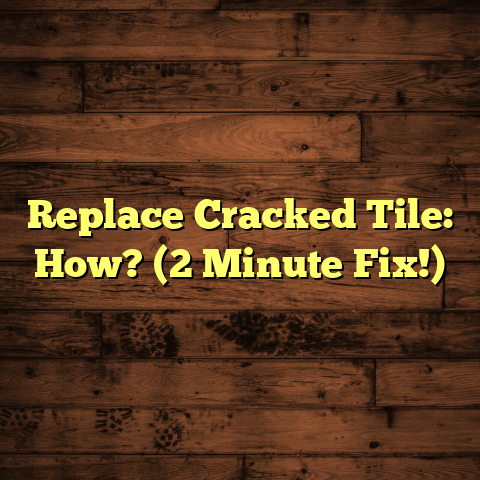MK Floor Box Dimensions: The Facts? (7 Key Specs!)
Have you ever tripped over a poorly installed floor box, or struggled to fit a bulky plug into one that’s too shallow?
I’ve been there, and believe me, it’s a pain!
Understanding the dimensions of MK floor boxes is absolutely crucial for any electrical or data installation.
It’s not just about fitting them into the floor; it’s about
safety, functionality, and even the overall aesthetics of
your space.
So, let’s dive deep into the world of MK floor
boxes and uncover the 7 key specs you need to know!
1. Overview of MK Floor Boxes
So, what exactly are MK floor boxes?
Well, in my experience, they’re essentially enclosures
recessed into the floor, designed to provide easy access
to electrical power, data, and telecommunications
outlets.
Think of them as convenient, hidden power
stations that keep your cables tidy and your floors
clutter-free.
In modern architecture and design, floor boxes are becoming increasingly vital.
They allow for flexible layouts in open-plan offices,
retail spaces, and even homes, without trailing wires
everywhere.
I’ve seen countless offices transformed by
strategically placed floor boxes, creating a clean and
professional environment.
2. Importance of Accurate Dimensions
Why is getting the dimensions right such a big deal?
I can tell you from experience, it’s everything.
If the dimensions are off, you’re looking at a whole host
of problems.
Firstly, installation becomes a nightmare.
Trying to squeeze a box that’s too big into a cutout that’s
too small is a recipe for disaster.
More importantly, incorrect dimensions can create safety
hazards.
A poorly fitted floor box can become a tripping
hazard, or worse, expose electrical connections to moisture
or physical damage.
Aesthetically, the wrong size floor box can stick out like a
sore thumb, ruining the look of your beautiful flooring.
I’ve had clients who were furious because their brand-new
wooden floor was marred by an ill-fitting, unsightly floor
box.
3. Key Specification 1: Standard Dimensions
Okay, let’s get down to the nitty-gritty.
What are the
standard sizes available for MK floor boxes?
Typically, you’ll find MK floor boxes in a range of sizes to
accommodate different needs.
Here’s a breakdown of
some common dimensions I’ve worked with:
-
Single Socket Boxes: These are usually around 86mm x 86mm (external dimensions).
-
Double Socket Boxes: These come in at roughly 86mm x 146mm.
-
Data/Communication Boxes: Dimensions vary depending on the number of ports, but a common size is around 86mm x 86mm for a single data outlet.
-
Multi-Compartment Boxes: These are larger, designed to house a combination of power and data, and can range from 146mm x 146mm to much larger sizes depending on the configuration.
It’s important to note that these are just general guidelines.
Always check the manufacturer’s specifications for the
exact dimensions of the specific MK floor box model you’re
using.
I’ve learned this the hard way, after assuming a
“standard” size and ending up with a box that didn’t quite
fit!
The type of installation also influences the size you’ll need.
Residential installations often use smaller, single or double socket boxes, while commercial settings tend to require larger, multi-compartment options.
4. Key Specification 2: Depth Requirements
Depth is another critical dimension to consider.
It’s not
just about how wide or long the box is, but how deep it
needs to be to accommodate the wiring and devices inside.
The depth of the floor box significantly impacts cable
management.
A shallow box can quickly become overcrowded,
making it difficult to connect and disconnect cables.
This
can lead to damaged wires, poor connections, and even
electrical hazards.
I’ve often found myself wrestling with tangled wires in shallow floor boxes, and it’s never a pleasant experience.
A deeper box provides more room to neatly organize the cables, reducing the risk of damage and making maintenance much easier.
The depth also determines what kind of devices you can
accommodate.
Some plugs and connectors are bulkier than
others, and require more space.
If you’re planning to use
large transformers or adapters, you’ll need a deeper floor
box to house them comfortably.
As a rule of thumb, I always recommend choosing a floor
box with a depth that’s slightly more than you think you’ll
need.
It’s better to have extra space than to be struggling to
cram everything in.
5. Key Specification 3: Material Considerations
The materials used in MK floor boxes play a significant role
in their overall dimensions and performance.
Common
materials include:
Metal (Steel or Aluminum): These are incredibly durable and offer excellent protection for the electrical components inside.
Metal boxes are often used in high- traffic areas where they’re likely to be subjected to heavy loads or impacts.Plastic (Polycarbonate or ABS): Plastic boxes are lighter and more resistant to corrosion than metal ones.
They’re often used in residential settings or areas where moisture is a concern.
The choice of material can influence the dimensions in
several ways.
For example, a metal box might require thicker
walls to provide adequate strength and protection, which
can increase its overall size.
Plastic boxes, on the other hand, can be made with thinner walls, allowing for a more compact design.
The material also affects the load-bearing capacity of the
floor box, which we’ll discuss in more detail later.
Metal
boxes generally have a higher load-bearing capacity than
plastic ones.
From a safety perspective, metal boxes are often preferred
because they provide better grounding and shielding against
electromagnetic interference.
However, plastic boxes are
non-conductive, which can reduce the risk of electric shock
in certain situations.
6. Key Specification 4: Load-Bearing Capacity
Load-bearing capacity is a crucial consideration, especially in commercial or industrial settings where floor boxes are likely to be subjected to heavy loads.
The dimensions of the floor box directly impact its load-
bearing capacity.
A larger, more robust box will generally
be able to withstand heavier loads than a smaller, more
delicate one.
The material of the floor box also plays a significant role.
Metal boxes, as mentioned earlier, typically have a higher
load-bearing capacity than plastic ones.
The manufacturer’s
specifications will usually indicate the maximum load that
the floor box can safely support.
I’ve seen cases where floor boxes were installed in areas
where they were regularly driven over by forklifts or other
heavy machinery.
In these situations, it’s absolutely
essential to choose a floor box with a high load-bearing
capacity to prevent damage and ensure safety.
Even in residential settings, load-bearing capacity can be
important.
If you’re planning to install a floor box under a
heavy piece of furniture, such as a sofa or a bookshelf, you’ll
need to make sure that the box can support the weight
without collapsing.
7. Key Specification 5: Accessibility and Compliance
Accessibility and compliance with regulations are also important factors to consider when choosing MK floor box dimensions.
Regulations like the Americans with Disabilities Act (ADA)
in the US and similar standards in other countries, dictate
certain requirements for accessibility in public spaces.
This
can affect the dimensions and placement of floor boxes.
For example, the ADA requires that floor surfaces be stable,
firm, and slip-resistant.
This means that floor boxes must be
flush with the surrounding flooring and have a non-slip
surface to prevent tripping hazards.
The dimensions of the floor box also need to be considered
in relation to the surrounding space.
The box shouldn’t
obstruct pathways or create obstacles for people with
disabilities.
Compliance with electrical codes is also essential.
These
codes specify requirements for the installation of electrical
equipment, including floor boxes.
The dimensions of the box
must comply with these codes to ensure safety and prevent
electrical hazards.
I always advise my clients to consult with a qualified electrician or building inspector to ensure that their floor box installations comply with all applicable regulations and standards.
8. Key Specification 6: Aesthetic Dimensions
While functionality and safety are paramount, the aesthetic
dimensions of floor boxes are also important.
After all, you
don’t want an ugly floor box ruining the look of your
beautiful flooring.
The dimensions of the floor box can affect how well it
integrates with the surrounding flooring materials.
A floor
box that’s too large or too small can look out of place and
detract from the overall aesthetics of the room.
I’ve worked on projects where the client specifically
requested floor boxes that were as discreet as possible,
blending seamlessly with the flooring.
In these cases, we
carefully selected floor boxes with dimensions that matched
the size and shape of the flooring tiles or planks.
Design trends also influence size preferences.
In recent
years, there’s been a growing trend towards minimalist
design, with a focus on clean lines and uncluttered spaces.
This has led to a demand for smaller, more discreet floor
boxes that don’t draw attention to themselves.
However, in other situations, a larger floor box might be
preferred.
For example, in a modern, industrial-style space,
a larger, more prominent floor box can be used as a design
element, adding to the overall aesthetic.
9. Key Specification 7: Customization Options
Finally, let’s talk about customization options.
While
standard-sized MK floor boxes are suitable for many
applications, there are times when you need a custom size
to meet specific requirements.
Custom-sized floor boxes can be particularly useful in
unique installations where standard sizes just won’t work.
For example, if you’re installing a floor box in an unusually
shaped room, or if you need to accommodate a specific
number of outlets or devices, a custom size might be the
only option.
The implications of customization are that you have greater
flexibility in terms of design and functionality.
You can
specify the exact dimensions you need to ensure a perfect fit
and optimal performance.
However, customization also comes with its own set of
challenges.
Custom-sized floor boxes are typically more
expensive and take longer to manufacture than standard
sizes.
You’ll also need to provide detailed specifications to
the manufacturer to ensure that the box is made to your
exact requirements.
I recall a project where we needed to install floor boxes in a
historic building with uneven floors.
Standard-sized boxes
wouldn’t have worked because they wouldn’t have sat flush
with the floor.
We ended up ordering custom-sized boxes
that were specifically designed to accommodate the
unevenness of the floor, resulting in a seamless and
professional-looking installation.
Conclusion
So, there you have it – the 7 key specs you need to know about MK floor box dimensions!
Understanding these specifications is crucial for ensuring a
successful installation, optimal functionality, and a pleasing
aesthetic.
From standard sizes and depth requirements to
material considerations and load-bearing capacity, each
dimension plays a vital role in the overall performance of
the floor box.
By carefully considering these factors, you can choose the
right MK floor box for your needs and avoid the common
pitfalls that can arise from incorrect dimensions.
Whether
you’re a seasoned electrician or a homeowner embarking on a
DIY project, I hope this article has provided you with the
knowledge you need to make informed decisions about
your floor box installations.





